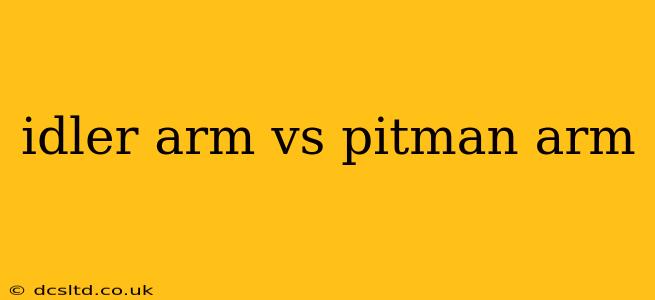The steering system of a vehicle is crucial for safe and controlled driving. Two important components often confused are the idler arm and the pitman arm. While both play vital roles in translating steering wheel movement into wheel movement, they have distinct functions and locations. Understanding their differences is key to effective vehicle maintenance and repair.
What is a Pitman Arm?
The pitman arm is the crucial link between the steering box and the rest of the steering linkage. It's directly connected to the output shaft of the steering gear (whether it's a recirculating ball, rack and pinion, or other type). When you turn the steering wheel, the pitman arm receives the rotational motion and transmits it to the rest of the steering linkage, ultimately causing the wheels to turn. Think of it as the primary translator of steering input. It's usually a relatively sturdy, forged steel component designed to withstand significant stress.
What is an Idler Arm?
The idler arm is a supporting component found in some steering systems, particularly those using a center-link and drag link setup (common in older vehicles). It's positioned in the center of the steering linkage, acting as a pivot point that allows the drag link to transmit the motion from the pitman arm to the steering knuckles (and therefore the wheels). Essentially, the idler arm stabilizes the drag link and reduces the amount of force required to turn the steering wheel. It is not directly connected to the steering box itself. In systems without an idler arm, the center link and drag link typically accomplish this function without an intermediary.
What is the Difference Between an Idler Arm and a Pitman Arm?
The primary difference boils down to function and connection:
- Pitman Arm: Directly connected to the steering box, it's the initial recipient of steering input.
- Idler Arm: An intermediary component in some steering systems, providing support and leverage to the steering linkage. It doesn't directly receive input from the steering box.
Think of it like a lever system. The pitman arm is the main lever, while the idler arm (if present) acts as a fulcrum or support point, facilitating the transfer of force.
How Do I Know If My Idler Arm or Pitman Arm Needs Replacing?
Several symptoms can indicate a problem with either component:
- Steering wheel play or looseness: Excessive movement in the steering wheel before the wheels respond indicates worn or damaged components.
- Unusual noises: Knocking or clunking sounds during steering, especially over bumps, could be due to worn ball joints or bushings within the idler arm or pitman arm assembly.
- Vibrations: Excessive vibrations felt in the steering wheel might indicate a problem within the steering linkage.
- Difficulty steering: Increased effort or stiffness in steering may result from binding or damaged components.
It's crucial to have a mechanic diagnose the specific problem. Replacing the wrong component will not solve the issue and could be dangerous.
What are the Symptoms of a Bad Idler Arm?
A failing idler arm often manifests as:
- Excessive play or looseness in the steering: This happens because the idler arm's bushing or ball joint has worn out, allowing excessive movement.
- Unusual noises when turning: Clicking, knocking, or clunking sounds, particularly when turning the steering wheel, are common.
- Worn or damaged idler arm bushing: visual inspection might show excessive wear on this component.
What are the Symptoms of a Bad Pitman Arm?
A failing pitman arm often presents similar symptoms, but also can include:
- Steering wheel vibration: Because the pitman arm is directly connected to the steering box, a failure can result in more significant vibrations in the steering wheel.
- Steering becomes heavy or difficult: The direct connection to the steering box means a problem with the pitman arm can drastically affect steering effort.
Can I Replace the Idler Arm or Pitman Arm Myself?
Replacing either component requires mechanical skill and specialized tools. It's generally recommended to have this work performed by a qualified mechanic. Improper installation can lead to unsafe driving conditions. Always consult your vehicle's repair manual for specific instructions and safety precautions.
This comprehensive explanation should address many common questions about idler arms and pitman arms, clarifying their distinct roles in the steering system. Remember, regular maintenance and professional inspection are vital to ensure safe and reliable vehicle operation.
